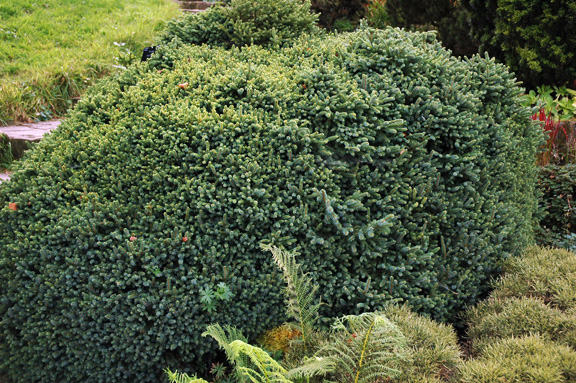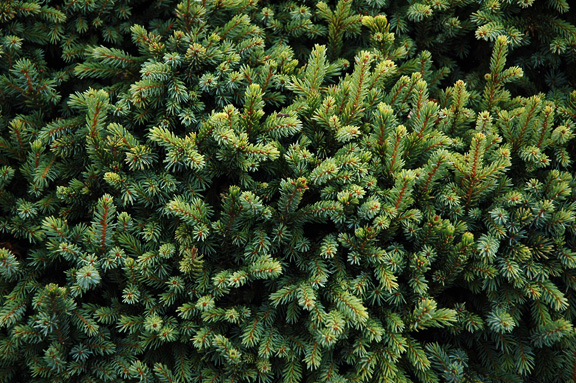
Woody > Picea > Picea mariana > Picea mariana 'Nana'
Picea mariana
'Nana'
Dwarf Black Spruce
Origin: Horticultural origin.
Mike's
Opinion


"
Originally grafted from the witches broom on a Picea mariana. It is grown in the landscape for the colourful evergreen foliage, interesting shape, texture and its small size. It can be used as a specimen, ornamental, or accent for rock gardens, foundations, shrub borders, ground cover, or edging. It is also used for erosion control and should be planted in groups to create a uniform planting. This particular cultivar does not produce any flowers.
Michael Pascoe, NDP., ODH., CLT., MSc. (Plant Conservation)
"
| Family |
| Pinaceae |
| Genus |
| Picea |
| Species |
| mariana |
| Cultivar |
| 'Nana' |
| Category |
| Woody |
| Type |
| Shrub (evergreen) |
| Pronunciation |
| USDA Hardiness Zone |
| 3–4 |
| Canadian Hardiness Zone |
| 5–6 |
| Temperature (°C) |
| -46 |
| Temperature (°F) |
| -50 |
| Height |
| 1 m |
| Spread |
| 1.5–2 m |
Photographs
Description and Growing Information
Flowering Period
| General Description |
| Is a small dense shrub with a compact nest like depression in its center. It is sometimes considered to be a mat forming cultivar and can be formed to be densely mounded. New growth is a blue-green colour which turns to a grey-green during the summer months. Branches of this cultivar radiate from the center of the shrub. It typically grows at a rate of 3 cm per year and takes around 10–20 years to mature. It will need regular watering, weekly or more often in extreme heat. It is known for attracting birds and being resistant to deer. |
| Landscape |
| Grown in the landscape for the colourful evergreen foliage, interesting shape, texture and its small size. Used as a specimen, ornamental, or accent for rock gardens, foundations, shrub borders, ground cover, or edging. It is useful for controlling erosion and should be planted in groups to create a uniform planting. |
| Cultivation |
| Likes full sun but will tolerate partially shaded areas. It thrives in high humidity and low temperatures, making it very hardy but somewhat sensitive to soil types. Since it prefers cool climates this cultivar will struggle in the high heats of the Deep South. Native to the Northern hemisphere, and is found in muskegs, bogs, bottom lands, dry peat lands, flatlands, and dry slopes in the vast Boreal forests that stretch from Alaska, across Canada as well as isolated growth occurring further south. It is grown easily in soils that are quite acidic. This species however prefers rich soils and soils that are moist but well drained. A regular watering schedule during the first season is important to establish a deep extensive root system. Once roots are established, watering can be reduced and the shrub becomes more low maintenance. |
| Shape |
| Round growth habit that appears mounded and had a slightly larger spread than its height. |
| Growth |
| Slow |
| ID Characteristic |
| Grown in the landscape for the colourful evergreen foliage, interesting shape, texture and its small size. It is densely mounded with a compact nest like depression in the center. New growth is a blue-green colour which turns to a grey-green during the summer months. It has flaky grey-brown plates. The young growth can be slightly variegated and usually bright green in the spring. Needles are also arranged in spirals along the branches. |
| Pests |
| There are no serious insect or disease problems. Eastern dwarf mistletoe, needle cast, needle rusts, and needle cankers are infrequent problems. You should watch for aphids, budworms and bagworms. |
| Bark/Stem Description |
| The bark is thin with flaky grey-brown plates or scales. |
| Flower/Leaf Bud Description |
| The buds are small in size, around 5–10 cm and are brown in colour. |
| Leaf Description |
| Attractive blue-green needles that are 14 mm in size. The needles are glacious and have rhombic cross sections, arranged in spirals around the branches. The needles are quiet flexible. The young growth can be slightly variegated and usually bright green in the spring. |
| Flower Description |
| This cultivar does not flower. |
| Fruit Description |
| This cultivar does not produce fruit. |
| Colour Description |
| The buds are brown in colour. Young needles are slightly variegated and usually bright green in the spring. The bark is grey-brown in colour. |
| Texture Description |
| Medium. |
| Notable Specimens |
| Royal Botanical Gardens, Hamilton, Ontario, Canada. |
| Propagation |
| Originally grafted from the witches broom of a Picea mariana, otherwise known as a Black Spruce; grafting or hard cuttings work best in the summer from the partially mature new growth and typically take two years to build a fully developed root system. |
References
"Pascoe's Plants A» Results." Pascoe's Plants A» Dwarf Black Spruce. Web. 07 Mar. 2012. .

